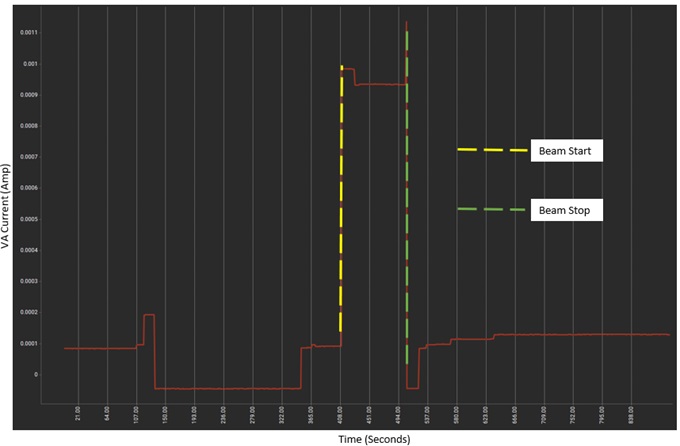SLAK033 December 2024 DAC121S101-SEP
5 Single-Event Latch-Up Results
During SEL characterization, the device was heated using forced hot air, maintaining the device temperature at 125°C. The temperature was monitored by means of a K-type thermocouple attached as close to the device as possible. The species used for SEL testing was a silver (47Ag) ion with an angle-of-incidence of 0° for an LETEFF = 43 MeV-cm2/mg. The kinetic energy in the vacuum for this ion is 1.634 GeV (15-MeV/amu line). A flux of approximately 105 ions/s-cm2and a fluence of approximately 107 ions/cm were used for three runs. The external voltage with the highest recommended voltage of 5.5V is applied onboard VA connector. The run duration to achieve this fluence was approximately 2 minutes. As shown in Table 5-1, no SEL events were observed during these three runs. Figure 5-1 shows the current plot vs time during beam exposure.
| Run # | Distance (mm) | Temperature (°C) | Ion | Angle | Flux (ions×cm2/mg) | Fluence (# ions) | LETEFF (MeV.cm2/mg) |
|---|---|---|---|---|---|---|---|
| 1 | 40 | 125 | Ag | 0° | 1.00E+05 | 1.00E+07 | 43 |
| 2 | 40 | 125 | Ag | 0° | 1.00E+05 | 1.00E+07 | 43 |
3 | 40 | 125 | Ag | 0° | 1.00E+05 | 1.50E+07 | 43 |
No SEL events were observed, indicating that the DAC121S101-SEP is SEL-immune at LETEFF = 43 MeV-cm2/mg and T = 125°C. Using the MFTF method described in Section 7 and combining (or summing) the fluences of the three runs at 125°C , the upper-bound cross section (using a 95% confidence level) is calculated in Equation 1:
where:
- LETEFF = 43 MeV-cm2/mg
- T = 125°C
 Figure 5-1 Current versus Time (I versus t) Data for VA Current During SEL Run
Figure 5-1 Current versus Time (I versus t) Data for VA Current During SEL Run